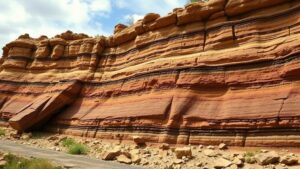Recognizing Geologic Features Associated with Gold Formation
Recognizing Geologic Features Associated with Gold Formation
Gold is a precious metal that has captured human interest for thousands of years due to its rarity, durability, and aesthetic appeal. Understanding the geologic features associated with gold formation is essential for exploration and mining endeavors. This article delves into the key geologic concepts, processes, and indicators that can help identify potential gold deposits.
The Geologic Setting of Gold Formation
Gold is typically found in igneous and metamorphic environments. It occurs in various forms, including native gold, as well as in ores such as pyrite and quartz. The two main types of gold deposits are lode and placer deposits, each associated with specific geologic features.
- Lode Deposits: These are primary deposits found within rocks, commonly associated with quartz veins and hydrothermal processes. They usually occur in mountainous regions where tectonic activities have created favorable conditions.
- Placer Deposits: These secondary deposits form from the weathering and erosion of lode deposits. Gold particles are transported by water to rivers, streams, and beaches, where they settle due to their density.
Geological Processes Contributing to Gold Formation
Several geological processes contribute to the concentration of gold in the Earths crust. These include:
- Hydrothermal Activity: Hot fluids rich in minerals can migrate through rock formations, causing the deposition of gold and other metals in cracks and fissures.
- Weathering and Erosion: Over time, surface processes break down primary deposits, enabling the transport and concentration of gold in downstream environments.
- Metamorphism: The alteration of rocks due to heat and pressure can pool gold within metamorphic rocks, often in association with quartz and sulfide minerals.
Key Geologic Features to Recognize
When exploring for gold, geologists look for specific features that indicate potential deposits. Such features include:
- Quartz Veins: The presence of quartz is often a strong indicator of gold deposits, particularly in lode form. Veins can vary in thickness and often contain visible gold.
- Fault Zones: Major structural faults create pathways for mineral-rich fluids, promoting the formation of lode deposits along these zones.
- Alluvial Fans: These formations build up where rivers or streams slow down, suggesting that gold from upstream sources could accumulate here.
- Gravel Bars: Often found in riverbeds, these can be rich in placer gold due to the natural sorting processes of water.
Real-World Case Studies
Several notable gold mining regions exemplify the connection between geologic features and gold deposits:
- The Witwatersrand Basin, South Africa: This area is renowned for its gold-bearing conglomerates, found in ancient riverbed deposits that have undergone metamorphism over billions of years. The basin has produced over 40% of the world’s gold.
- The Carlin Trend, Nevada: Known for its large lode deposits, the Carlin Trend showcases the significance of fault zones and hydrothermal systems in gold formation. The gold here is often microscopic, occurring mainly within arsenic-rich pyrite.
Conclusion and Actionable Takeaways
Recognizing geologic features associated with gold formation is crucial for any prospecting endeavor. By understanding the types of deposits, geological processes, and key indicators such as quartz veins and fault zones, both amateur and professional prospectors can enhance their chances of discovering gold. So:
- Conduct thorough geological surveys in regions with known gold mining history.
- Use geological mapping tools to identify potential features such as quartz veins and fault lines.
- Stay informed on recent geological studies and advancements in mining technology that could refine exploration techniques.



